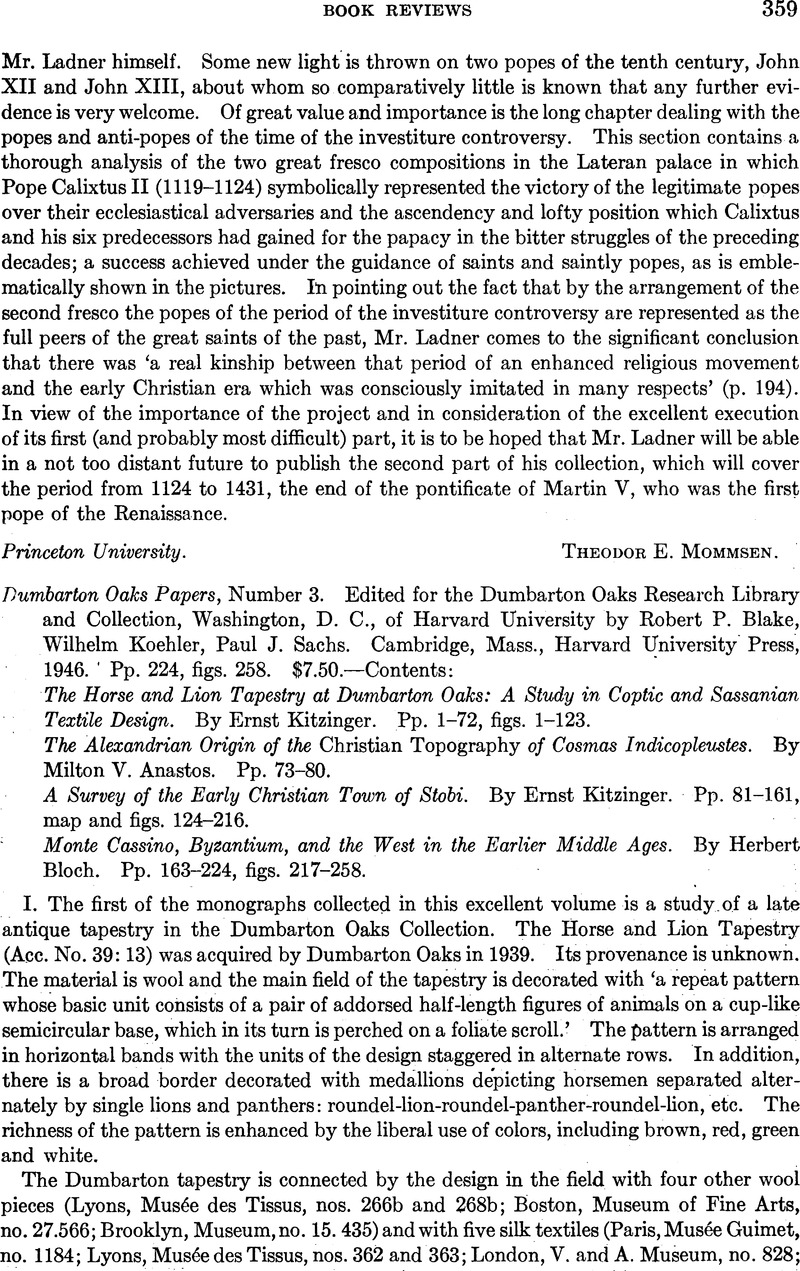No CrossRef data available.
Article contents
Dumbarton Oaks Papers, Number 3. Edited for the Dumbarton Oaks Research Library and Collection, Washington, D. C., of Harvard University by Robert P. Blake, Wilhelm Koehler, Paul J. Sachs Cambridge, Mass., Harvard University Press, 1946. Pp. 224, figs. 258. $7.50.—Contents: - The Horse and Lion Tapestry at Dumbarton Oaks: A Study in Coptic and Sassanian Textile Design. By Ernst Kitzinger. Pp. 1–72, figs. 1–123. - The Alexandrian Origin of the Christian Topography of Cosmas Indicopleustes. By Anastos Milton V.. Pp. 73–80. - A Survey of the Early Christian Town of Stobi. By Ernst Kitzinger. Pp. 81–161, map and figs. 124–216. - Monte Cassino, Byzantium, and the West in the Earlier Middle Ages. By Herbert Bloch. Pp. 163–224, figs. 217–258.
Published online by Cambridge University Press: 29 July 2016
Abstract

- Type
- Book Reviews
- Information
- Copyright
- Copyright © 1947 by Cosmopolitan Science & Art Service Co., Inc.
References
page 361 note 1 Are these capitals related in shape to some cubic capitals from the Episcopal Church in Stobi, published by Kitzinger in the monograph reviewed below? They are illustrated in figures 211–215, inclusive. The Stobi capitals are decorated with floral motifs, but they appear to be related to the bird capitals in shape and design. Figure 215 is very close. The Stobi capitals are dated in the sixth century.Google Scholar
page 363 note 2 The English translation was made by D. J. Chitty. The document was published with a Latin translation by the Patriarch Rahmani at Mainz in 1899. This Latin version is quoted in full in Kaufmann, , Handbuch der christlichen Archaeologie (1922) 164. The English translation is from the original Syrian, not from the Latin version.Google Scholar
page 364 note 3 Cf. DACL 12, 1952 for a good account of the history of this ceremony and a description of it.Google Scholar
page 365 note 4 The annex rooms are large enough to permit such use of them; the squarish room is about 6.35 m. long and a trifle less in width; the long room would be about 11.08 m. × 4.76 m.Google Scholar
page 365 note 5 Cf. Gerasa 178 n. 9 for a practice in the Church of the Holy Sepulchre which parallels this dual use of the diakonikon. Google Scholar
page 365 note 6 In view of the fact that this monograph aims in part at giving aid to those who do not read the less commonly known languages, such terms as ‘theca’ might have been translated rather than transliterated (thēkē would be a better equivalent of the Modern Greek values of the letters) and some explanation given of what is meant by ‘dedicational flask’; otherwise the fact that this is a reliquary is not clear. Kitzinger cites Deltion 1918, Parartema p. 33 and figs. 48–50 for this. A better reference is Ephemeris 1929, pp. 239–241, especially p. 241 and figs. 72–74. There are clear drawings of the thēkē and the contents of the flask is given.Google Scholar
page 370 note 1 To the same artist of Vat. lat. 1202 and Case. 99 we may also ascribe the pen drawings of Naples, Bibl. Nat. VIII. C. 4, of the time of abbot Oderisius I (1087–1107).Google Scholar




